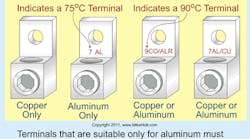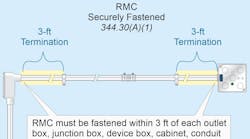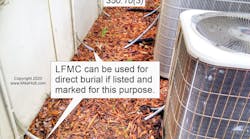Q. Are there any Code requirements related to terminals used for the connection of aluminum conductors?
A. Yes. Conductor terminal and splicing devices must be identified for the conductor material and they must be properly installed [110.14], as shown in the Figure. Connectors and terminals for conductors more finely stranded than Class B and Class C, as shown in Table 10 of Chapter 9, must be identified for the conductor class. See the definition of "Identified" in Art. 100.
According to UL Standard 486 A-B, a terminal/lug/connector must be listed and marked for use with conductors stranded in other than Class B. With no marking or factory literature/instructions to the contrary, terminals may only be used with Class B stranded conductors.
Switches and receptacles marked CO/ALR are designed to ensure a good connection through the use of the larger contact area and compatible materials. The terminal screws are plated with the element called "Indium." Indium is an extremely soft metal that forms a gas-sealed connection with the aluminum conductor.
Conductor terminations must comply with the manufacturer's instructions as required by 110.3(B). For example, if the instructions for the device state, "Suitable for 18-12 AWG Stranded," then only stranded conductors can be used with the terminating device. If the instructions state, "Suitable for 18-12 AWG Solid," then only solid conductors are permitted. If the instructions state, "Suitable for 18-12 AWG," then either solid or stranded conductors can be used with the terminating device.
Copper and aluminum conductors must not make contact with each other in a device unless the device is listed and identified for this purpose. Few terminations are listed for the mixing of aluminum and copper conductors, but if they are, that will be marked on the product package or terminal device. The reason copper and aluminum shouldn't be in contact with each other is because corrosion develops between the two different metals due to galvanic action, resulting in increased contact resistance at the splicing device. This increased resistance can cause the splice to overheat and cause a fire.
Note: Many terminations and equipment are marked with a tightening torque (see Table I.1 in Informative Annex I of the NEC). Conductors must terminate in devices that have been properly tightened in accordance with the manufacturer's torque specifications included with equipment instructions. Failure to torque terminals can result in excessive heating of terminals or splicing devices due to a loose connection. A loose connection can also lead to arcing which increases the heating effect and also may lead to a short circuit or ground fault. Any of these can result in a fire or other failure, including an arc-flash event. In addition, this is a violation of 110.3(B), which requires all equipment to be installed in accordance with listing or labeling instructions.
What do you do if the torque value isn't provided with the device? Call the manufacturer, visit the manufacturer's website, or have the supplier make a copy of the installation instructions. Terminating conductors without a torque tool can result in an improper and unsafe installation. If a torque screwdriver isn't used, there’s a good chance the conductors aren't properly terminated.





